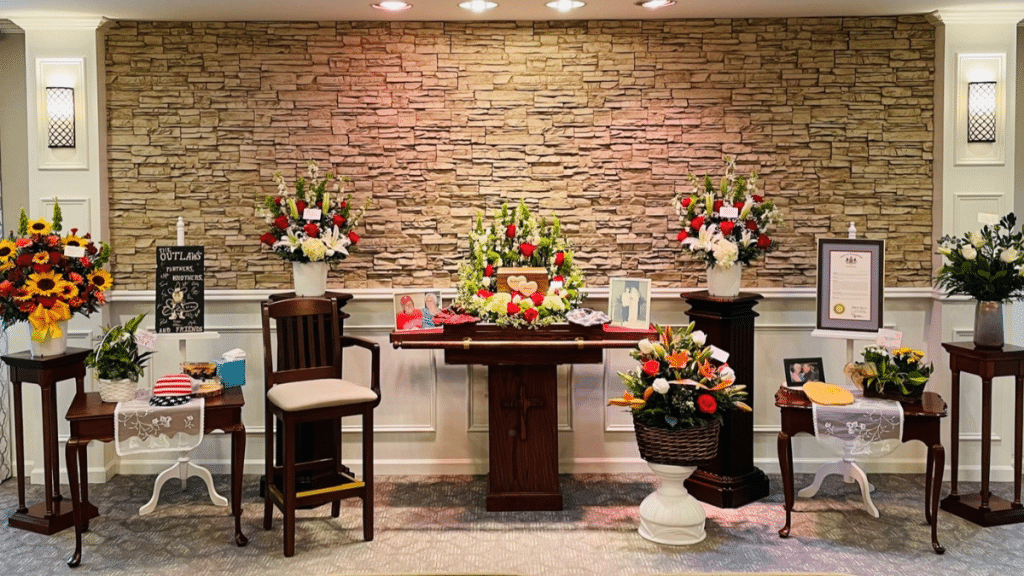A memorial service offers space to honor, remember, and reflect. After cremation services, families often have more freedom in how and when they choose to gather. This flexibility can make the planning feel less rushed but also more open-ended. Some families find that helpful. Others may feel uncertain about where to begin.
The goal is to create a respectful tribute that matches the life, personality, and values of the person who passed away. Careful planning allows for that expression, even during grief.
How Is It Different from a Traditional Funeral?
The main difference lies in the presence. A traditional funeral usually includes the body in a casket, often before burial. A cremation memorial service takes place after cremation. The urn replaces the casket as the focal point.
The structure remains similar. Most services still feature opening remarks, prayers or poems, eulogies, shared memories, and music. What changes is the tone. A cremation memorial often feels more relaxed and open to personalization.
Timing also differs. A traditional funeral usually happens within a few days of death. A cremation memorial may take place weeks or months later. This allows time for long-distance travel and detailed planning.
What Elements Are Included in the Service?
A cremation memorial often begins with a welcome or greeting. Someone leads the service—this may be a celebrant, clergy member, or trusted family friend. Words of comfort are followed by eulogies, tributes, and sometimes readings or songs.
The urn is usually placed at the front. Families may surround it with meaningful objects—photos, medals, artwork, or handwritten notes. Some services include slideshows or live music. Others rely on silence, prayer, and storytelling.
Every service reflects the personality of the person who passed. A teacher may be remembered with notes from former students. A musician may be honored through live performance. A parent’s service may include stories told by children and grandchildren.
Where Can a Cremation Memorial Take Place?
Families choose from a wide range of locations. Common choices include funeral home chapels, churches, community centers, or private homes. Others select more personal spaces like gardens, parks, beaches, or even restaurants.
The service can also be held at a cemetery if the urn will be buried or placed in a columbarium. Graveside services often include prayers, final words, and the formal placing of the urn.
Wherever the location, the space should feel welcoming, accessible, and suited to the number of guests.
What Is the Tone of a Cremation Memorial?
Tone depends on the wishes of the family and the nature of the life being honored. Some services feel reverent and quiet. Others embrace warmth and humor. Most fall somewhere in between—blending grief with gratitude and sorrow with celebration.
Unlike traditional funerals, cremation memorials give more freedom. The service can be deeply spiritual or entirely non-religious. A family might use poetry and song instead of scripture. Others may light candles or release balloons.
Tone also affects dress code, décor, and overall mood. Some families ask guests to wear bright colors. Others choose a more formal, black attire. There is no fixed rule. What matters is that the tone feels true to the life being honored.
Who Leads the Service?
Many cremation memorials are led by a celebrant or a close family member. Others invite a pastor, priest, or spiritual guide. Some services have no official leader. In those cases, guests may be invited to share thoughts freely, one by one.
The leader sets the pace. They welcome guests, guide the order of events, and close the service with final thoughts or blessings. A master of ceremonies does not have to be a professional. A steady, compassionate voice is what matters most.
Why Do Families Choose a Cremation Memorial?
Families choose cremation memorials for many reasons. Flexibility is often the key. Cremation allows time to plan, gather, and personalize. Families who feel rushed by traditional timelines often find relief in this option.
Cremation also reduces cost. Without the need for embalming, caskets, or urgent arrangements, families can focus on meaning rather than logistics.
The service also offers emotional value. People come to express grief, share stories, and support each other. A well-planned memorial becomes a turning point in the healing process. It marks not only the loss but also the life.
Can Cremation Memorials Include Burial?
Yes. Some families choose to bury the urn after the service. Others place it in a columbarium niche. These options provide a permanent place for visitation and reflection.
A short burial or inurnment ceremony may follow the memorial. These gatherings often involve final prayers, words of farewell, or simple rituals like placing flowers or soil over the site.
This combination of memorial and interment blends remembrance with closure.
What Makes the Service Meaningful?
The details make it meaningful. A thoughtful speaker. A favorite song. A display of photos that tell a story. A room filled with people who care. These touches do more than honor a life—they remind the living that connection still remains.
Families do not need grand productions. What they need is truth, comfort, and presence. A cremation memorial provides space for all three.
In summary, a cremation memorial service is a flexible, personal, and respectful way to say goodbye. It honors the deceased with words, symbols, and shared moments—without the constraints of traditional funeral customs. With care and intention, this kind of service can help begin the long, quiet process of healing.
